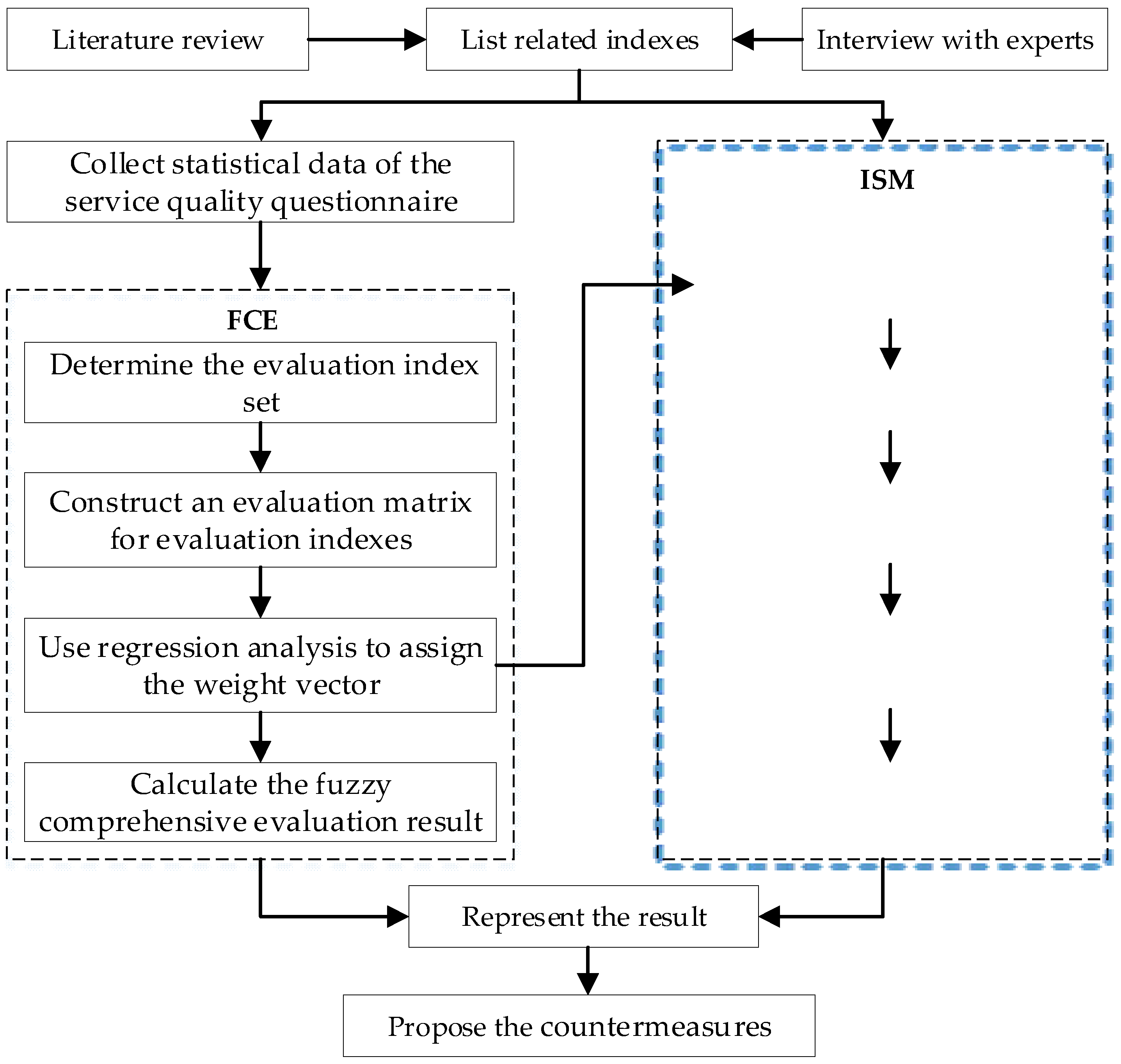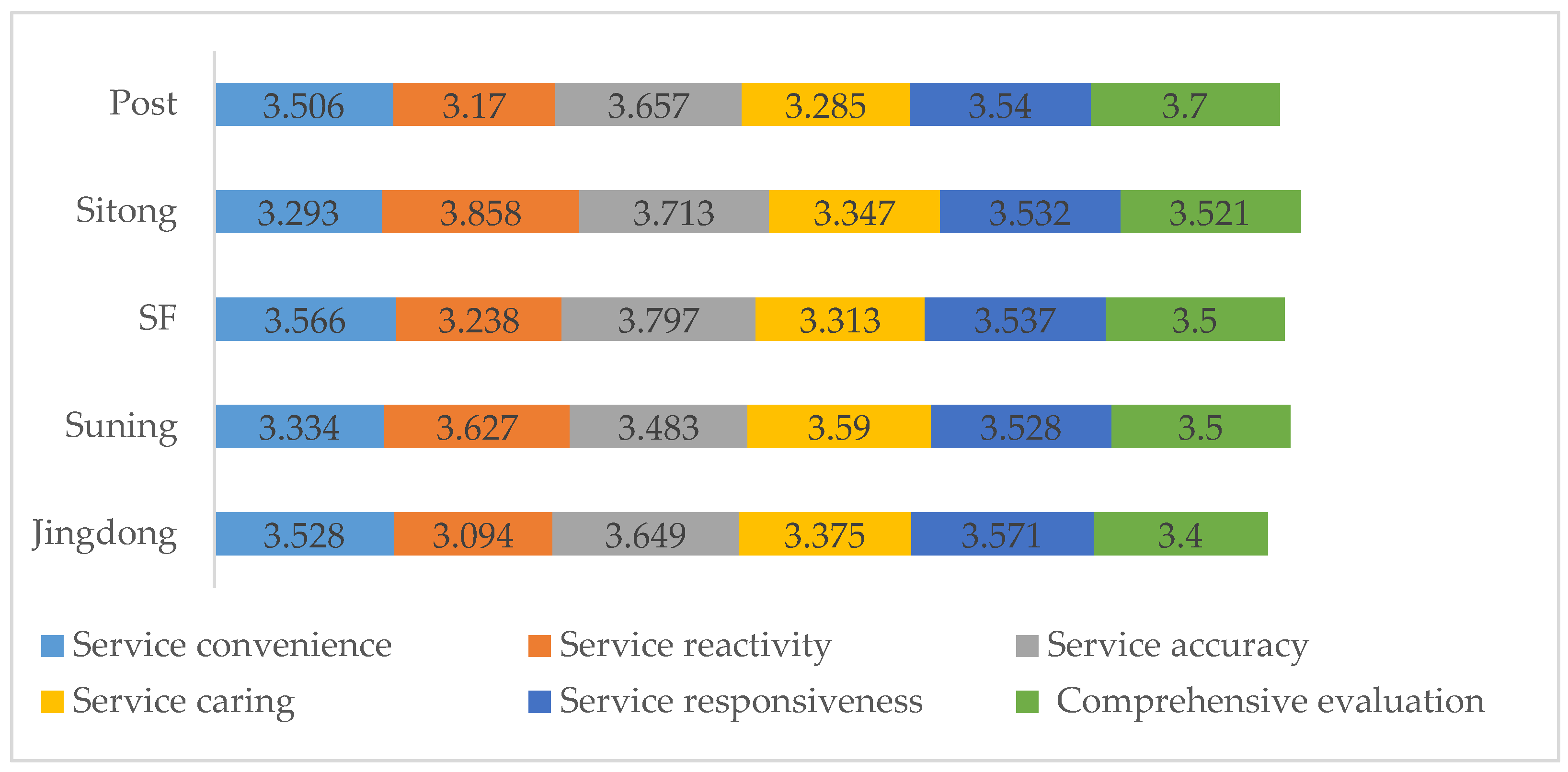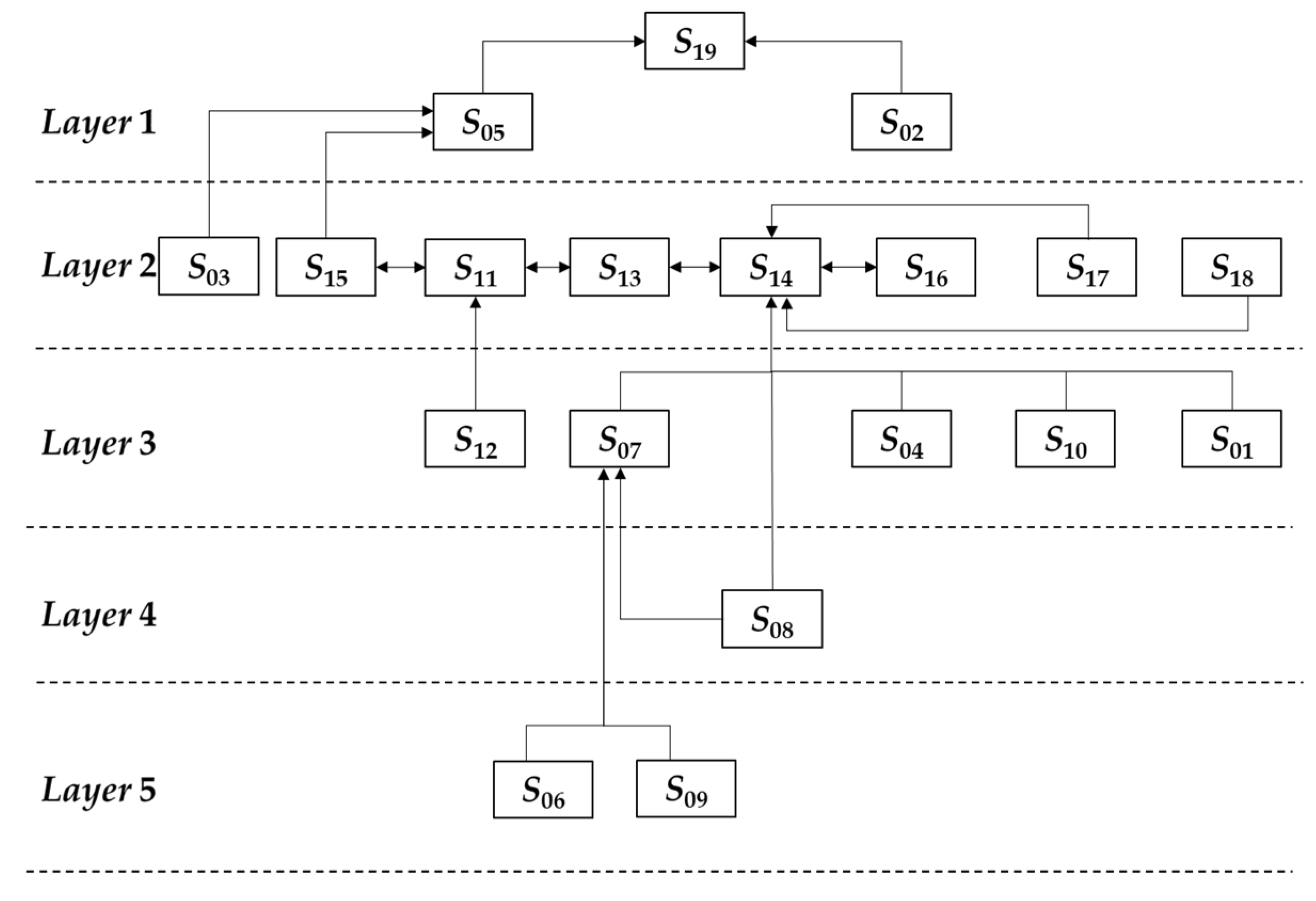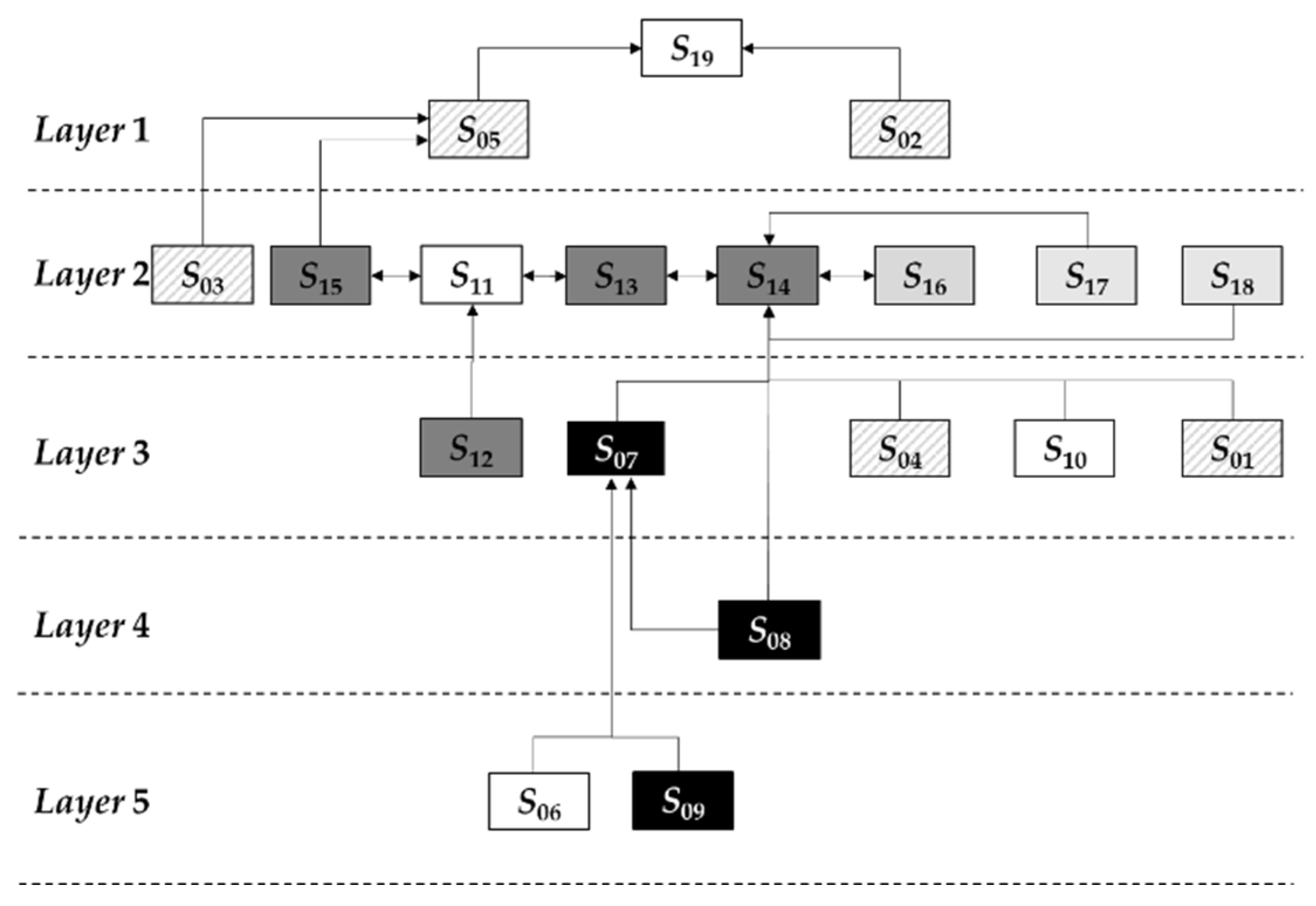Analyzing Service Quality Evaluation Indexes of Rural Last Mile Delivery Using FCE and ISM Approach
Abstract
1. Introduction
2. Literature Review
3. Research Methodology
3.1. Service Quality Evaluation Indexes Selecting
- Change “Tangibility” to “Convenience”
- Add “Reactivity”
- Retain “Accuracy”
- Retain “Caring”
- Retain “Responsiveness”
3.2. Service Quality Questionnaire Based on Customer Satisfaction
3.3. Fuzzy Comprehensive Evaluation
3.4. Interpretative Structural Model
- (1)
- If i has no impact on j, aij = 0; else, aij = 1, and vice versa;
- (2)
- If the two indexes impact each other, then aij = aji = 1;
- (3)
- If the two indexes do not impact each other, then aij = aji = 0;
- (4)
- When i = j, then aij = aji = 0;
- (5)
- aij = aji = 0 for any key indexes.
3.5. The Integrated Methodology
4. Empirical Analysis
4.1. FCE Result
4.2. ISM Result
5. Discussion
6. Conclusions
Author Contributions
Funding
Acknowledgments
Conflicts of Interest
References
- Li, R.L.; Zhang, H.P. China rural logistics market and its characteristics. Chin. Mark. 2008, 6, 138–139. [Google Scholar]
- Li, X. An integrated modeling framework for design of logistics networks with expedited shipment services. Transp. Res. Part E Logist. Transp. Rev. 2013, 56, 46–63. [Google Scholar] [CrossRef]
- Zhu, Q.; Sarkis, J.; Geng, Y. Green supply chain management in China: Pressures, practices and performance. Int. J. Oper. Prod. Manag. 2005, 25, 449–468. [Google Scholar] [CrossRef]
- Parasuraman, A.; Zeithaml, V.; Berry, L. A conceptual model of service quality and its implications for future research. J. Mark. 1985, 49, 41–50. [Google Scholar] [CrossRef]
- Parasuraman, A.; Zeithaml, A.; Berry, L. SERVQUAL: A multiple-item scale for measuring consumer perceptions of service quality. J. Retail. 1988, 13, 12–40. [Google Scholar]
- Parasuraman, A.; Zeithaml, V.A.; Malhotra, A. E-S-Qual: A multiple-item scale for assessing electronic service quality. J. Serv. Res. 2005, 7, 213–233. [Google Scholar] [CrossRef]
- Mentzer, J.T.; Flint, D.J.; Hult, T.M. Logistics service quality as segment-customized process. J. Mark. 2001, 65, 82–104. [Google Scholar] [CrossRef]
- Roberts, K.; Varki, S.; Brodie, R. Measuring the quality of relationships in consumer services: An Empirical Study. Eur. J. Mark. 2003, 37, 169–196. [Google Scholar] [CrossRef]
- Rafiq, M.; Jaafar, H.S. Measuring customers’ perceptions of logistics service quality of 3PL service providers. J. Bus. Logist. 2007, 28, 159–175. [Google Scholar] [CrossRef]
- Cristobal, E.; Flavian, C.; Guinaliu, M. Perceived e-service quality (PeSQ): Measurement validation and effects on consumer satisfaction and web site loyalty. Manag. Serv. Q. 2007, 17, 317–340. [Google Scholar]
- Norizan Kassim, N.A.A. The effect of perceived service quality dimensions on customer satisfaction, trust, and loyalty in e-commerce settings: A cross cultural analysis. Asia Pac. J. Mark. Logist. 2010, 22, 351–371. [Google Scholar] [CrossRef]
- Saura, R.-M.; Palos-Sanchez, P. Are Black Friday Deals Worth It? Mining Twitter Users’ Sentiment and Behavior Response. J. Open Innov. Technol. Mark. Complex. 2019, 5, 58. [Google Scholar] [CrossRef]
- So, S.; Kim, J.J.; Cheong, K.; Cho, G. Evaluating the service quality of TPL service providers using the analytic hierarchy process. J. Inf. Syst. Technol. Manag. 2006, 3, 261–270. [Google Scholar]
- Ghorbanzadeh, O.; Moslem, S.; Blaschke, T.; Duleba, S. Sustainable urban transport planning considering different stakeholder groups by an interval-AHP decision support model. Sustainability 2018, 11, 9. [Google Scholar] [CrossRef]
- Chen, K.; Chang, C.; Lai, C. Service quality gaps of business customers in the shipping industry. Trans. Res. Part E Logist. Trans. Rev. 2009, 45, 222–237. [Google Scholar] [CrossRef]
- Tansakul, C.H.; Buddhakulsomsiri, J.; Wasusri, T.; Chaiwat, P.; Kritjaroen, T. A gap analysis in service quality of Thai logistics service providers. In Proceedings of the 4th International Conference on Engineering, Project, and Production Management EPPM, Bangkok, Thailand, 23–25 October 2013; pp. 537–550. [Google Scholar]
- Li, Y.; Liu, X.; Chen, Y. Selection of logistics center location using Axiomatic Fuzzy Set and TOPSIS methodology in logistics management. Expert Syst. Appl. 2011, 38, 7901–7908. [Google Scholar] [CrossRef]
- Kilibarda, M.; Zecˇevic, S.; Vidovic, M. Measuring the quality of logistic service as an element of the logistics provider offering. Total Qual. Manag. 2012, 23, 1345–1361. [Google Scholar] [CrossRef]
- Juga, J.J.; Juntunen, D.B. Grant. Service quality and its relation to satisfaction and loyalty in logistics and outsourcing relationships. Manag. Serv. Qual. Int. J. 2010, 20, 496–510. [Google Scholar] [CrossRef]
- Zailani, S.; Jafarzadeh, S.; Iranmanesh, M.; Nikbin, D.; Selim, N. Halal logistics service quality: Conceptual model and empirical evidence. Br. Food J. 2018, 120, 2599–2614. [Google Scholar] [CrossRef]
- Warfield, J.N. Toward interpretation of complex structural models. Syst. Manag. Cybern. IEEE Trans. 1974, 4, 405–417. [Google Scholar] [CrossRef]
- Thakkar, J.; Deshmukh, S.G.; Gupta, A.D.; Shankar, R. Development of a balanced scorecard: An integrated approach of Interpretive Structural Modeling (ISM) and Analytic Network Process (ANP). Int. J. Oper. Perform. Manag. 2007, 56, 25–59. [Google Scholar] [CrossRef]
- Han, Y.; Geng, Z.; Zhu, Q.; Lin, X. Energy consumption hierarchical analysis based on interpretative structural model for ethylene production. Chin. J. Chem. Eng. 2015, 23, 2029–2036. [Google Scholar] [CrossRef]
- Thirupathi, R.M.; Vinodh, S. Application of interpretive structural modelling and structural equation modelling for analysis of sustainable manufacturing factors in Indian automotive component sector. Int. J. Prod. Res. 2016, 54, 6661–6682. [Google Scholar] [CrossRef]
- Cherrafi, A.; Elfezazi, S.; Garza-Reyes, J.A.; Benhida, K.; Mokhlis, A. Barriers in green lean implementation: A combined systematic literature review and interpretive structural modelling approach. Prod. Plan. Control 2017, 28, 829–842. [Google Scholar] [CrossRef]
- Fu, K.; Xia, J.-B.; Zhang, X.-Y.; Shen, J. System structural analysis of communication networks based on DEMATEL-ISM and entropy. J. Cent. South Univ. 2017, 24, 1594–1601. [Google Scholar] [CrossRef]
- Jiang, X.; Wang, H.; Guo, X.; Gong, X. Using the FAHP, ISM, and MICMAC Approaches to Study the Sustainability Influencing Factors of the Last Mile Delivery of Rural E-Commerce Logistics. Sustainability 2019, 11, 3937. [Google Scholar] [CrossRef]
- Mohanty, M.; Shankar, R. Modelling uncertainty in sustainable integrated logistics using Fuzzy-TISM. Transp. Res. Part D Transp. Environ. 2017, 53, 21. [Google Scholar] [CrossRef]
- Tian, Y.Q.; Hua, L.I.; Shang, X.G. Study on affecting factors of risks at workplace based on ISM and AHP. China Saf. Sci. J. 2011, 21, 140–146. [Google Scholar]
- Khatwani, G.; Singh, S.P.; Trivedi, A.; Chauhan, A. Fuzzy-TISM: A fuzzy extension of TISM for group decision making. Glob. J. Flex. Syst. Manag. 2015, 16, 97–112. [Google Scholar] [CrossRef]
- Duleba, S.; Shimazaki, Y.; Mishina, T. An analysis on the connections of factors in a public transport system by AHP-ISM. Transport 2013, 28, 404–412. [Google Scholar] [CrossRef]
- Liu, P.; Li, Q.; Bian, J.; Song, L.; Xiahou, X. Using interpretative structural modeling to identify critical success factors for safety management in subway construction: A China study. Int. J. Environ. Res. Public Health 2018, 15, 1359. [Google Scholar] [CrossRef] [PubMed]
- Kannan, G.; Pokharel, S.; Kumar, P.S. A hybrid approach using ISM and fuzzy TOPSIS for the selection of reverse logistics provider. Resour. Conserv. Recycl. 2009, 54, 28–36. [Google Scholar] [CrossRef]
- Yang, Z.; Fang, X. Online service quality dimensions and their relationships with satisfaction. Int. J. Serv. Ind. Manag. 2004, 15, 302–326. [Google Scholar] [CrossRef]
- Zeithaml, V.A.; Parasuraman, A.; Malhotra, A. A conceptual framework for understanding e-service quality: Implications for future research and managerial practice. In Working Paper, Report No. 00-115; Marketing Science Institute: Cambridge, MA, USA, 2001. [Google Scholar]
- Cox, J.; Dale, B.G. Service quality and e-commerce: An exploratory analysis. Manag. Serv. Qual. 2001, 11, 121–131. [Google Scholar] [CrossRef]
- Liu, C.; Arnett, K. Exploring the factors associated with web site success in the context of electronic commerce. Inf. Manag. 2000, 38, 23–33. [Google Scholar] [CrossRef]
- Ribbink, D.; van Riel, A.C.R.; Liljander, V.; Streukens, S. Comfort your online customer: Quality, trust, and loyalty on the internet. Manag. Serv. Qual. 2004, 14, 446–456. [Google Scholar] [CrossRef]
- Barnes, S.J.; Vidgen, R.T. An integrative approach to the assessment of e-commerce quality. J. Electron. Commer. Res. 2002, 3, 114–127. [Google Scholar]
- Loiacono, E.T.; Watson, R.T.; Goodhue, D.L. Webqual: A web site quality instrument. In Working Paper 2000-126-0; University of Georgia: Athens, GA, USA, 2000. [Google Scholar]
- Yoo, B.; Donthu, N. Developing a scale to measure the perceived service quality of internet shopping sites (sitequal). Q. J. Electron. Commer. 2001, 2, 31–47. [Google Scholar]
- Madu, C.N.; Madu, A.A. Dimensions of e-quality. Int. J. Qual. Reliab. Manag. 2002, 19, 246–258. [Google Scholar] [CrossRef]
- Lin, Y.; Lin, L. Research on LAN Performance Evaluation Based on Fuzzy Comprehensive Evaluation Method. J. Phys. Conf. Ser. 2019, 1325, 12047. [Google Scholar] [CrossRef]








| Dimension | Evaluation Indexes | Adapted From |
|---|---|---|
| Service convenience (B1) | Rationality of distribution layout (S01) | Yang (2004) [34], Zeithaml (2001) [35], Cox and Dale (2001) [36], Liu and Arnett (2000) [37], van Riel (2004) [38], Barnes and Vidgen (2002) [39] |
| Convenience of payment (S02) | ||
| Convenience of Information query (S03) | ||
| Convenience of the delivery time setting (S04) | ||
| Convenience of the delivery (S05) | ||
| Service reactivity (B2) | Timely customer service response (S06) | Loiacono (2000) [40], Yoo and Donthu (2001) [41], Madu (2002) [42], Zeithaml (2001) [43] |
| Rationality of damaged or lost goods process (S07) | ||
| Timely processing of damaged or lost goods (S08) | ||
| Service accuracy (B3) | Accuracy of goods arrival (S09) | Madu (2002) [42], Liu and Arnett (2000) [37], van Riel (2004) [38], Barnes and Vidgen (2002) [39], Yang (2004) [34] |
| Accuracy of logistics information (S10) | ||
| Strict regulation of the signing processing (S11) | ||
| Service caring (B4) | Notification after goods arrival timely (S12) | Liu and Arnett (2000) [37], van Riel (2004) [38], Barnes and Vidgen (2002) [39], Yang (2004) [34] |
| Employees remind customers to open the packages actively (S13) | ||
| Employees’ service attitude (S14) | ||
| Employees ask what other needs actively (S15) | ||
| Service responsiveness (B5) | Timely pick-up (S16) | Loiacono (2000) [40], Yoo and Donthu (2001) [41], Madu (2002) [42], Zeithaml (2001) [35], Parasuraman (2005) [6] |
| Timely goods delivery (S17) | ||
| Timely goods arrival (S18) |
| Independent Variable | Unstandardized Coefficients | Standardized Coefficients | Confidence Coefficient | Significance | |
|---|---|---|---|---|---|
| Regression Coefficient | Standard Error | Regression Coefficient | |||
| Service convenience | 0.262 | 0.021 | 0.283 | 2.339 | 0.028 |
| Service reactivity | 0.144 | 0.012 | 0.156 | 1.912 | 0.067 |
| Service accuracy | 0.167 | 0.013 | 0.181 | 0.739 | 0.467 |
| Service caring | 0.195 | 0.016 | 0.211 | 1.138 | 0.266 |
| Service responsiveness | 0.156 | 0.013 | 0.169 | 2.385 | 0.025 |
| Dependent variable: logistics service quality | |||||
| Indexes | B1 | B2 | B3 | B4 | B5 | Proportion | Rank |
|---|---|---|---|---|---|---|---|
| 0.283 | 0.156 | 0.181 | 0.211 | 0.169 | |||
| S01 | 0.173 | 0 | 0 | 0 | 0 | 0.048959 | 18 |
| S02 | 0.198 | 0 | 0 | 0 | 0 | 0.056034 | 8 |
| S03 | 0.225 | 0 | 0 | 0 | 0 | 0.063675 | 2 |
| S04 | 0.210 | 0 | 0 | 0 | 0 | 0.059430 | 5 |
| S05 | 0.188 | 0 | 0 | 0 | 0 | 0.053770 | 11 |
| S06 | 0 | 0.351 | 0 | 0 | 0 | 0.054756 | 9 |
| S07 | 0 | 0.324 | 0 | 0 | 0 | 0.050544 | 15 |
| S08 | 0 | 0.325 | 0 | 0 | 0 | 0.050700 | 14 |
| S09 | 0 | 0 | 0.354 | 0 | 0 | 0.064074 | 1 |
| S10 | 0 | 0 | 0.344 | 0 | 0 | 0.062264 | 3 |
| S11 | 0 | 0 | 0.302 | 0 | 0 | 0.054662 | 10 |
| S12 | 0 | 0 | 0 | 0.276 | 0 | 0.060840 | 4 |
| S13 | 0 | 0 | 0 | 0.251 | 0 | 0.052961 | 12 |
| S14 | 0 | 0 | 0 | 0.239 | 0 | 0.050429 | 16 |
| S15 | 0 | 0 | 0 | 0.234 | 0 | 0.049374 | 17 |
| S16 | 0 | 0 | 0 | 0 | 0.334 | 0.056446 | 7 |
| S17 | 0 | 0 | 0 | 0 | 0.306 | 0.051714 | 13 |
| S18 | 0 | 0 | 0 | 0 | 0.360 | 0.058236 | 6 |
| Indexes | R(Si) | A(Si) | R(Si)∩A(Si) |
|---|---|---|---|
| S01 | 1, 5, 11, 13–18 | 1 | 1 |
| S02 | 2 | 2 | 2 |
| S03 | 3, 5 | 3 | 3 |
| S04 | 4, 5, 11, 13–18 | 4 | 4 |
| S05 | 5 | 1, 3, 4–18 | 5 |
| S06 | 5, 6, 7, 8, 11, 13–18 | 6 | 6 |
| S07 | 5, 7, 11, 13–18 | 6, 7, 8, 9 | 7 |
| S08 | 5, 7, 8, 11, 13–18 | 6, 8, 9 | 8 |
| S09 | 5, 7, 8, 9, 11 | 9 | 9 |
| S10 | 5, 10, 11, 13–18 | 10 | 10 |
| S11 | 5, 11, 13–18 | 1, 4, 6–18 | 13–18 |
| S12 | 5, 11, 12, 13–18 | 12 | 12 |
| S13 | 5, 11, 13–18 | 1, 4, 6–18 | 11, 13–18 |
| S14 | 5, 11, 13–18 | 1, 4, 6–18 | 11, 13–18 |
| S15 | 5, 11, 13–18 | 1, 4, 6–18 | 11, 13–18 |
| S16 | 5, 11, 13–18 | 1, 4, 6–18 | 11, 13–18 |
| S17 | 5, 11, 13–18 | 1, 4, 6–18 | 11, 13–18 |
| S18 | 5, 11, 13–18 | 1, 4, 6–18 | 11, 13–18 |
© 2020 by the authors. Licensee MDPI, Basel, Switzerland. This article is an open access article distributed under the terms and conditions of the Creative Commons Attribution (CC BY) license (http://creativecommons.org/licenses/by/4.0/).
Share and Cite
Jiang, X.; Wang, H.; Guo, X. Analyzing Service Quality Evaluation Indexes of Rural Last Mile Delivery Using FCE and ISM Approach. Information 2020, 11, 327. https://doi.org/10.3390/info11060327
Jiang X, Wang H, Guo X. Analyzing Service Quality Evaluation Indexes of Rural Last Mile Delivery Using FCE and ISM Approach. Information. 2020; 11(6):327. https://doi.org/10.3390/info11060327
Chicago/Turabian StyleJiang, Xiaohong, Huiying Wang, and Xiucheng Guo. 2020. "Analyzing Service Quality Evaluation Indexes of Rural Last Mile Delivery Using FCE and ISM Approach" Information 11, no. 6: 327. https://doi.org/10.3390/info11060327
APA StyleJiang, X., Wang, H., & Guo, X. (2020). Analyzing Service Quality Evaluation Indexes of Rural Last Mile Delivery Using FCE and ISM Approach. Information, 11(6), 327. https://doi.org/10.3390/info11060327





